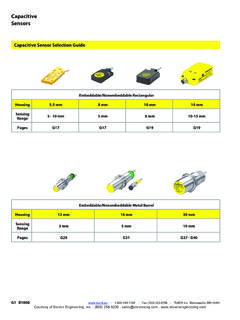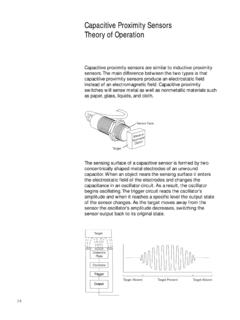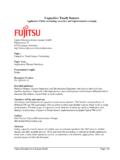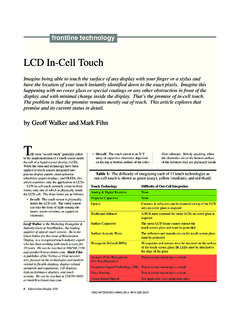Transcription of Capacitive-Based Liquid Level Sensing Sensor ... - …
1 TIDU736A January 2015 Revised March 2015 Capacitive-Based Liquid Level Sensing Sensor Reference Design 1 Copyright 2014, Texas Instruments Incorporated TI Designs: Capacitive-Based Liquid Level Sensing Sensor Reference Design TI Designs Design FeaturesTI Designs provide the foundation that you need including methodology, testing and design files to quickly evaluate and customize the system. TI Designs help you accelerate your time to market. Design Resources TIDA-00317 Design Folder FDC1004 Product Folder Block Diagram TIDA-00317 Level SensorHEADERREFERENCE Liquid SensorShieldsREFERENCE ENVIRONMENT Sensor Liquid Level Sensing using capacitive Sensing technology Out-of-Phase (OoP) technique eliminates any proximity interference such as a human hand either nearby or in contact with the container Rigid-flex circuit allows the sensors to be placed on various shaped surfaces Liquid height resolution <1mm Includes the environmental reference Sensor to help compensate for environmental changes (temperature, humidity, stress on container, )
2 Developed to be paired with the FDC1004 EVM and FDC1004 EVM GUI for quick prototyping evaluation Featured Applications Home Appliances: refrigerators, coffee machines, humidifiers Automotive: fuel Level , washer fluid, coolant Level Medical: drug pens, insulin pumps, droplet counter Ask The Analog Experts WEBENCH Design Center Capacitive-Based Liquid Level Sensing Sensor Reference Design TIDU736A January 2015 Revised March 2015 2 Copyright 2014, Texas Instruments Incorporated Table of Contents 1 Key System Specifications .. 3 2 System Description .. 4 3 Block 5 Highlighted Products .. 5 4 System Design Theory.
3 6 Level Height Calculations .. 6 The Out-of-Phase Liquid Level Technique .. 8 Sensor Layout .. 9 Sensor Design Considerations .. 10 5 Getting Started Hardware .. 11 Hardware Overview .. 11 FDC1004 EVM GUI Configuration .. 11 6 Test Setup .. 13 7 Test Data .. 14 Liquid Level Data .. 14 Parasitic Capacitance Interference .. 15 8 Design Files .. 17 Schematics .. 17 Bill of Materials .. 17 Layout Plots .. 18 Layout Guidelines .. 20 Gerber files .. 21 9 References .. 22 10 About the Author .. 22 TIDU736A January 2015 Revised March 2015 Capacitive-Based Liquid Level Sensing Sensor Reference Design 3 Copyright 2014, Texas Instruments Incorporated 1 Key System Specifications Table 1.
4 Key System Specifications PARAMETER SPECIFICATION DETAILS Sensor size Sensitivity resolution <1mm Section Sensor configuration Out-of-phase method for robustness Section Sensitivity Level height resolution <1mm Section Parasitic capacitance interference Tested with human body self-capacitance approaching Sensor /container Section Capacitive-Based Liquid Level Sensing Sensor Reference Design TIDU736A January 2015 Revised March 2015 4 Copyright 2014, Texas Instruments Incorporated 2 System Description Various methods have been used to determine the Liquid Level height in water containers, but recently, capacitive Sensing has gained popularity due to the accuracy and resolution of the measurements.
5 The conventional capacitive technique has limitations with robustness since any external interference (for example a human hand) causes capacitance drifts. This TI Design demonstrates an alternative approach to the conventional capacitive Sensing technique for Liquid Level . It provides the necessary barrier to minimize any interference to maximum the signal to noise ratio and overall robustness of the system. This approach is referred to as the Out-of-Phase (OoP) technique. The OoP technique relies on a symmetrical Sensor layout as well as using the shield drivers in a unique way to stabilize measurements. This Sensor design paired with the FDC1004 EVM and GUI allows the user a simple and rapid way to prototype and evaluate this Liquid Level technique.
6 This design guide addresses the theory behind the OoP technique, the Sensor layout, and Sensor design considerations for system environment changes. The scope of this design guide gives system designers a head-start in integrating TI s capacitive Sensing technology into new Liquid Level applications that require robustness and high resolution. TIDU736A January 2015 Revised March 2015 Capacitive-Based Liquid Level Sensing Sensor Reference Design 5 Copyright 2014, Texas Instruments Incorporated 3 Block Diagram TIDA-00317 Level SensorHEADERREFERENCE Liquid SensorShieldsREFERENCE ENVIRONMENT Sensor Figure 1: Capacitive-Based Liquid Level Sensing Sensor block diagram Highlighted Products The Capacitive-Based Liquid Level Sensing reference design is based on the FDC1004 capacitance-to-digital converter.
7 However, it focuses on the Sensor layout. It was designed to be paired with the FDC1004 EVM and GUI as a modular system. FDC1004 EVM The FDC1004 EVM is a plug and play system to test and evaluate the FDC1004, 4-channel capacitive to digital converter. The EVM is a breakable PCB which consists of 3 sections: 1. MSP430F5528 microcontroller which acts as the USB to I2C bridge between a PC and the FDC1004. 2. The FDC1004 3. Touchless Sensor to demonstrate the sensitivity of the FDC1004 Key benefits of the FDC1004 EVM: Does not need additional hardware, calibration, nor any software programming Only requires the FDC1004 EVM GUI to be installed on a host PC GUI is able to configure the FDC1004 s registers, display the capacitive values on four graphs (one for each measurement)
8 , and export data in CSV format Capacitive-Based Liquid Level Sensing Sensor Reference Design TIDU736A January 2015 Revised March 2015 6 Copyright 2014, Texas Instruments Incorporated 4 System Design Theory Level Height Calculations Liquid Level Sensing is based on the theory of a ratiometric measurement, using three sensors as shown in Figure 2: 1. Level The capacitance of the Level electrode is proportional to the Liquid height (hw). It has to be as high as the maximum (MAX) allowed Liquid Level . 2. REFERENCE Liquid (RL) The REFERENCE Liquid electrode accounts for the incremental unit measurements of the Level electrode.
9 The Liquid Level has to be higher than the RL height in order to have a Liquid and temperature independent measurement system. 3. REFERENCE ENVIRONMENT (RE) A second (optional) reference electrode accounts for container properties. It has to be placed above the maximum (MAX) allow Level of Liquid to isolate it from the Liquid Level , allowing it to track environmental factors rather than the primary target (the Liquid in the container). A key aspect of this approach is that all three sensors are driven with the same excitation signal. Changes in the excitation signal due to changing capacitance are measured and used to calculate the corresponding Liquid Level .
10 HLLEVELRLREMAXhRhWhRGroundCINxSHIELDYXZG NDGNDGND Figure 2: Ratiometric measurement setup The working principle of the Liquid Level Sensing involves measuring the fringing capacitance between the primary Level electrode (CINx) and a ground (GND) electrode in the parallel fingers topology. The fringing capacitance becomes a function of the dielectric variation in the x-axis direction, and proportional to the Liquid height, as given by: +( ) Equation 1: Capacitance proportional due to dielectric variation Where hL = maximum height of the Liquid hw = height of Liquid w = dielectric of Liquid a = dielectric of air TIDU736A January 2015 Revised March 2015 Capacitive-Based Liquid Level Sensing Sensor Reference Design 7 Copyright 2014, Texas Instruments Incorporated To calculate the Level of the Liquid at any interval height, the formula below is used: = (0) Equation 2.














